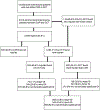Prevalence and Clinical Import of Thoracic Injury Identified by Chest Computed Tomography but Not Chest Radiography in Blunt Trauma: Multicenter Prospective Cohort Study
- PMID: 26169926
- PMCID: PMC6755136
- DOI: 10.1016/j.annemergmed.2015.06.003
Prevalence and Clinical Import of Thoracic Injury Identified by Chest Computed Tomography but Not Chest Radiography in Blunt Trauma: Multicenter Prospective Cohort Study
Abstract
Study objective: Chest computed tomography (CT) diagnoses more injuries than chest radiography, so-called occult injuries. Wide availability of chest CT has driven substantial increase in emergency department use, although the incidence and clinical significance of chest CT findings have not been fully described. We determine the frequency, severity, and clinical import of occult injury, as determined by changes in management. These data will better inform clinical decisions, need for chest CT, and odds of intervention.
Methods: Our sample included prospective data (2009 to 2013) on 5,912 patients at 10 Level I trauma center EDs with both chest radiography and chest CT at physician discretion. These patients were 40.6% of 14,553 enrolled in the parent study who had either chest radiography or chest CT. Occult injuries were pneumothorax, hemothorax, sternal or greater than 2 rib fractures, pulmonary contusion, thoracic spine or scapula fracture, and diaphragm or great vessel injury found on chest CT but not on preceding chest radiography. A priori, we categorized thoracic injuries as major (having invasive procedures), minor (observation or inpatient pain control >24 hours), or of no clinical significance. Primary outcome was prevalence and proportion of occult injury with major interventions of chest tube, mechanical ventilation, or surgery. Secondary outcome was minor interventions of admission rate or observation hours because of occult injury.
Results: Two thousand forty-eight patients (34.6%) had chest injury on chest radiography or chest CT, whereas 1,454 of these patients (71.0%, 24.6% of all patients) had occult injury. Of these, in 954 patients (46.6% of injured, 16.1% of total), chest CT found injuries not observed on immediately preceding chest radiography. In 500 more patients (24.4% of injured patients, 8.5% of all patients), chest radiography found some injury, but chest CT found occult injury. Chest radiography found all injuries in only 29.0% of injured patients. Two hundred and two patients with occult injury (of 1,454, 13.9%) had major interventions, 343 of 1,454 (23.6%) had minor interventions, and 909 (62.5%) had no intervention. Patients with occult injury included 514 with pulmonary contusions (of 682 total, 75.4% occult), 405 with pneumothorax (of 597 total, 67.8% occult), 184 with hemothorax (of 230 total, 80.0% occult), those with greater than 2 rib fractures (n=672/1,120, 60.0% occult) or sternal fracture (n=269/281, 95.7% occult), 12 with great vessel injury (of 18 total, 66.7% occult), 5 with diaphragm injury (of 6, 83.3% occult), and 537 with multiple occult injuries. Interventions for patients with occult injury included mechanical ventilation for 31 of 514 patients with pulmonary contusion (6.0%), chest tube for 118 of 405 patients with pneumothorax (29.1%), and 75 of 184 patients with hemothorax (40.8%). Inpatient pain control or observation greater than 24 hours was conducted for 183 of 672 patients with rib fractures (27.2%) and 79 of 269 with sternal fractures (29.4%). Three of 12 (25%) patients with occult great vessel injuries had surgery. Repeated imaging was conducted for 50.6% of patients with occult injury (88.1% chest radiography, 11.9% chest CT, 7.5% both). For patients with occult injury, 90.9% (1,321/1,454) were admitted, with 9.1% observed in the ED for median 6.9 hours. Forty-four percent of observed patients were then admitted (4.0% of patients with occult injury).
Conclusion: In a more seriously injured subset of patients with blunt trauma who had both chest radiography and chest CT, occult injuries were found by chest CT in 71% of those with thoracic injuries and one fourth of all those with blunt chest trauma. More than one third of occult injury had intervention (37.5%). Chest tubes composed 76.2% of occult injury major interventions, with observation or inpatient pain control greater than 24 hours in 32.4% of occult fractures. Only 1 in 20 patients with occult injury was discharged home from the ED. For these patients with blunt trauma, chest CT is useful to identify otherwise occult injuries.
Copyright © 2015 American College of Emergency Physicians. Published by Elsevier Inc. All rights reserved.
Figures

Comment in
-
Prevalence and Clinical Import of Thoracic Injury Identified by Chest Computed Tomography but Not Chest Radiography in Blunt Trauma: Multicenter Prospective Cohort Study.Ann Emerg Med. 2016 Jul;68(1):133-4. doi: 10.1016/j.annemergmed.2016.03.033. Ann Emerg Med. 2016. PMID: 27343649 No abstract available.
-
In reply.Ann Emerg Med. 2016 Jul;68(1):134-5. doi: 10.1016/j.annemergmed.2016.03.032. Ann Emerg Med. 2016. PMID: 27343650 No abstract available.
References
-
- Optimal Care of the Trauma Patient: Resources for Optimal Care of the Injured Patient 2014. American College of Surgeons Committee on Trauma; Rotondo MF, Cribari C, Smith RS, eds. Chicago, IL; 2014. page 80.
-
- Medicare Payment Advisory Commission. A data book: healthcare spending and the Medicare program. Page 107, chart 7–19 June 2014. Available at: http://www.medpac.gov/documents/publications/jun14databookentirereport.p... Accessed March 4, 2015.
-
- Kaewlai R, Avery LL, Asrani AV, et al. Multidetector CT of blunt thoracic trauma. Radiographics. 2008;28:1555–1570. - PubMed
-
- American College of Surgeons Committee on Trauma Leadership. National Trauma Data Bank (NTDB) annual report 2007. In: Clark DE, Fantus RJ, eds. Chicago, IL: American College of Surgeons; 2007: 1–64.
-
- Mayberry JC. Imaging in thoracic trauma: the trauma surgeon’s perspective. J Thorac Imaging. 2000;15:76–86. - PubMed
Publication types
MeSH terms
Grants and funding
LinkOut - more resources
Full Text Sources
Other Literature Sources
Medical

